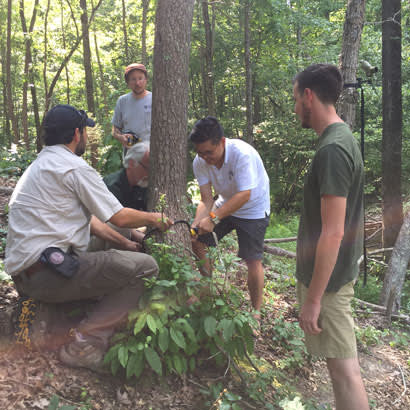
The Mecklenburg County Park and Recreation Department (MCPR) is typical of most park and recreation departments nationwide in that we provide high-quality leisure facilities and programming for the residents of Charlotte, North Carolina. However, MCPR is also one of the leading municipal park agencies to focus on natural-resource stewardship by having an entire division dedicated to natural resource protection, nature preserve land management, and facility operations and environmental education.
Mecklenburg County Division of Nature Preserves and Natural Resources’ mission is to “protect the region’s biodiversity and natural heritage for its inherent value and for the benefit of future generations by promoting open-space preservation, conserving natural communities, and fostering awareness and stewardship through environmental education and outdoor recreation.” MCPR nature preserves protect and enhance air and water quality; contribute to the public understanding of natural systems and native species; provide sites for educational activities, outdoor recreation, wildlife observation and nature appreciation; and preserve the unique features and natural beauty of Mecklenburg County. Our dedicated natural resources staff collects and analyzes scientific data used for land management, planning and in the land use decision-making process. Staff identify, inventory and monitor natural areas; maintain the largest wildlife database in the region; manage for rare, threatened and federally endangered species; and provide technical assistance to government agencies, outside organizations and the public.
Why Bats?
Currently, one of our focus areas is understanding the dynamics of bat populations in our urban park/nature preserve system. Why bats? Well, Bat Conservation International notes: “Earth without bats would be a very different and much poorer place. More than 1,300 species of bats around the world are playing ecological roles that are vital to the health of natural ecosystems and human economies.
Bat species consume vast amounts of insects, including some of the most damaging agricultural pests. Others pollinate many valuable plants, ensuring the production of fruits that support local economies, as well as diverse animal populations. Bats are often considered “keystone species” that are essential to some tropical and desert ecosystems. Without bats’ pollination and seed-dispersing services, local ecosystems could gradually collapse, as plants fail to provide food and cover for wildlife species near the base of the food chain.
Despite not being in a tropical or desert setting, bat species found in North Carolina are a critical part of our native ecosystem. And, as in many parts of the world, our bat species face challenges, not only from habitat loss but also to disease. The North Carolina Wildlife Resources Commission (NCWRC) indicates that:“Pesticides, persecution, and human disturbance of hibernacula (winter habitat) and maternity colonies may have contributed to this decline. Furthermore, an emergent fungal disease, called white-nose syndrome (WNS), has killed more than 5.7 million bats since its discovery in New York in 2006. This disease spread to North Carolina in 2011, and continues to spread to new states each winter. It is now found in 30 states.
“To determine bat distribution and hibernation sites in North Carolina, track the spread of WNS, and estimate population trends for certain species, the NCWRC conducts monitoring across the state. Through a variety of methods (including mist netting, trapping, banding, acoustic recording, roost monitoring and radio telemetry), NCWRC biologists, in cooperation with several partners, have surveyed and banded thousands of bats in North Carolina. All this work helps to inform management.”
How MCPR Is Helping
MCPR, in support of this effort, teamed up with Dr. Han Li, a post-doctoral fellow and research scientist at the University of North Carolina - Greensboro, who studies bats and their sounds. As they fly, bats make high-frequency sounds that they use as sonar. Those sounds travel through the air until they bounce off an object and return to the bat as an echo. Bats calculate the distance to the object by processing the time required for the sound to return and, thus, determine the shape, size and texture of objects and its surroundings.
Essentially, bats create a digital picture of their environment in their brain as they fly around. Each bat species has a specific sonar “voice” or signal, so, by recording bat calls at night and analyzing them with a computer and software, researchers can determine which bat species live around Charlotte and their geographic distribution in our area.
Beginning in the summer of 2016, the Natural Resources Section began collecting its first round of data, identifying the bats that occur in Mecklenburg County. Staff used a series of Anabat SD2 echolocators and directional microphones in the nature preserve to collect and record bat calls. Once collected, the sound files were analyzed using a computer program, called Analook, which compared the recorded bat pulses with a call library of known bat calls.
For four nights in July 2016, staff monitored bat calls at Reedy Creek Nature Preserve and was surprised to learn that there were seven distinct species, including the Big Brown Bat, Evening Bat, Hoary Bat, Red Bat, Silver-haired Bat and Tricolored Bat and that the preserve is one of the northernmost roosting locations for the Mexican Freetail Bat. Then, in the spring of 2017, our recorders picked up an eighth species in Reedy Creek, the federally endangered Gray Bat. This recording is quite unusual as the Gray Bat is a cave-dwelling species from the Midwest. Now we have a real mystery on our hands — isn’t science cool?!
In addition to trying to learn more about the possible occurrence of the Gray Bat, our next major effort is to see what bat species exist in our urban core. As we move to the Uptown Charlotte area, we’re hoping to learn if bats use highly urbanized habitat different from natural habitat and if we will see the same species. Stay tuned to this frequency for more information on the bats of Mecklenburg County!
Chris Matthews is the Division Director, Nature Preserves and Natural Resources for Mecklenburg County Park & Recreation.

